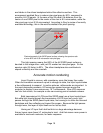
Page 26
Optical Actuators. Most microdisplay projectors offer a one-to-one
relationship between the pixels on the microdisplay and the pixels on the screen.
But in a move oddly reminiscent of interlace scanning, recent projection systems
divide each display frame into two "subframes." A pivoting mirror outside the
display panel called an optical actuator toggles the screen image back and forth.
The system shows the pixels of the first subframe, then toggles to show the
pixels of the second.
Original data
for 20 pixels
Data split into
Subframe A (shown in
green) and Subframe
B (shown in red), 10
pixels each.
Addressed pixels
with optical actuator
in position 1.
Data = Subframe A
Addressed pixels with
optical actuator in
position 2, half pixel
offset from position 1.
Data = Subframe B
20 pixels shown using
a chip with half the
resolution and half the
frame duration given to
each subframe.
An "optical actuator" works to double the native resolution of the panel
itself.
The optical actuator system also uses a different orientation for the pixels.
Instead of an "orthogonal" array, arranged in vertical columns and horizontal
rows, the optical actual system adopts a diamond or diagonal pixel array.
In the optical actuator system, a diagonal array pixel (left) shares its area
with four adjacent pixels. An orthogonal array pixel (right) never shares
its area.


















